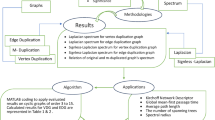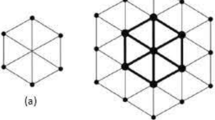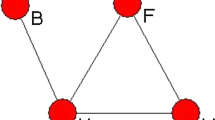Abstract
Applications of graph theory exist in many science disciplines including chemistry, physics, medicine, and engineering. Since computational methods as well as computer-based approaches are less expensive and efficient, these techniques are very helpful to analyze chemical compounds. Chemical graph theory is a field that includes such kinds of analyses of chemical structures. Graph descriptors, also referred as topological indices, are graph invariants that help to study different structural properties of chemical substances. Such descriptors also aid to understand different activities related to chemical compounds. The main objective of this study is to find the best appropriate index to estimate the heat of formation of \(SF_6\). Initially, we compute degree-based topological indices, co-indices, and reverse indices for Sulfur hexafluoride. A similarity measure is used for feature selection. A network of the indices is constructed based on a similarity measure which is defined using Euclidean distance and Pearson correlation. Next, twenty-one subnetworks of the network consisting of highly similar indices, referred as modules, are captured. One module is containing 13 indices, three are containing 2 indices, and all the remaining modules are comprised of only one vertex. Hierarchical clustering is used to verify the detected modules. From each module one index, called master regulatory index (\(\mathcal {MRI}\)), is selected for further study. Afterward, the thermodynamical measure heat of formation (\(\mathcal {HOF}\)) is computed. A correlation analysis is done between each master regulatory index and heat of formation to capture any uncorrelated feature, if exists. Finally, mathematical formulations between each \(\mathcal {MRI}\) and \(\mathcal {HOF}\) are estimated. The best estimate is selected based on root mean squared error.














Similar content being viewed by others
Data Availability Statement
There is no data used to support the findings.
References
A.T. Balaban, Applications of graph theory in chemistry. J. Chem. Info. Comput. Sci. 25(3), 334–343 (1985)
D. Bonchev, Chemical graph theory: introduction and fundamentals (Vol. 1). CRC Press, 1-100 (1991)
M. Randić, C.L. Wilkins, Graph theoretical approach to recognition of structural similarity in molecules. J. Chem. Inf. Comput. Sci. 19(1), 31–37 (1979)
A. Graovac, T. Pisanski, On the Wiener index of a graph. J. Math. Chem. 8(1), 53–62 (1991)
Z.Q. Chu, M.K. Siddiqui, S. Manzoor, S.A.K. Kirmani, M.F. Hanif, M.H. Muhammad, On rational curve fitting between topological indices and entropy measures for graphite carbon nitride. Polycycl. Arom. Compd. 10, 1–18 (2022)
S. Manzoor, M.K. Siddiqui, S. Ahmad, On physical analysis of degree-based entropy measures for metal-organic superlattices. Eur. Phys. J. Plus 136(3), 1–22 (2021)
S. Manzoor, M.K. Siddiqui, S. Ahmad, Computation of entropy measures for phthalocyanines and porphyrin dendrimers. Int. J. Quant. Chem. 122(5), 174–268 (2022)
X. Zhang, H.M. Awais, M. Javaid, M.K. Siddiqui, Multiplicative Zagreb indices of molecular graphs. J. Chem. 2019, 1–19 (2019)
X. Zhang, H. Jiang, J.B. Liu, Z. Shao, The cartesian product and join graphs on edge-version atom-bond connectivity and geometric arithmetic indices. Molecules 23(7), 17–31 (2018)
Z. Shao, M.K. Siddiqui, M.H. Muhammad, Computing zagreb indices and zagreb polynomials for symmetrical nanotubes. Symmetry 10(7), 244–260 (2018)
W. Gao, M.K. Siddiqui, M. Naeem, N.A. Rehman, Topological characterization of carbon graphite and crystal cubic carbon structures. Molecules 22(9), 1496–1515 (2017)
X. Zhang, A. Rauf, M. Ishtiaq, M.K. Siddiqui, M.H. Muhammad, On degree based topological properties of two carbon nanotubes. Polycycl. Arom. Compd. 42(3), 866–884 (2022)
X. Zhang, M. Naeem, A.Q. Baig, M.A. Zahid, Study of hardness of superhard crystals by topological indices. J. Chem. 2021, 1–10 (2021)
X. Zhang, M.K. Siddiqui, S. Javed, L. Sherin, F. Kausar, M.H. Muhammad, Physical analysis of heat for formation and entropy of Ceria Oxide using topological indices. Combinat. Chem. High Throughput Screen. 25(3), 441–450 (2022)
X. Zhang, Z. Zhang, N. Chidambaram, S. Jaganathan, N. Devadoss, V. Ravi, On degree and distance-based topological indices of certain interconnection networks. Eur. Phys. J. Plus 137(7), 1–15 (2022)
K.D. Rainsford, Anti-inflammatory drugs in the 21st century. Inflammation in the pathogenesis of chronic diseases: the COX-2 controversy, 3-27 (2007)
B. Bollobás, P. Erdos, Graphs of extremal weights. Ars Combinatoria 50, 225–233 (1998)
Xiujun Zhang, Muhammad Tanzeel Kanwal, Azeem Ali, Jamil Muhammad, Muhammad Kamran, Muzammil Mukhtar, Finite vertex-based resolvability of supramolecular chain in dialkyltin. Main Group Metal Chem. 45, 255–264 (2022)
E. Estrada, L. Torres, L. Rodriguez, I. Gutman, An atom-bond connectivity index: modelling the enthalpy of formation of alkanes. Indian J. Chem 37A, 849–855 (1998)
W. Gao, W.F. Wang, M.K. Jamil, R. Farooq, M.R. Farahani, Generalized atom-bond connectivity analysis of several chemical molecular graphs. Bulgarian Chem. Commun. 48(3), 543–549 (2016)
D. Vukičević, B. Furtula, Topological index based on the ratios of geometrical and arithmetical means of end-vertex degrees of edges. J. Math. Chem. 46(4), 1369–1376 (2009)
K.C. Das, I. Gutman, Some properties of the second Zagreb index. MATCH Commun. Math. Comput. Chem 52(1), 13–21 (2004)
I. Gutman et al., Graph theory and molecular orbitals. XII. Acyclic polyenes. J. Chem. Phys.s 62(9), 3399–3405 (1975)
B. Furtula, I. Gutman, A forgotten topological index. J. Math. Chem. 53(4), 1184–1190 (2015)
D. Wang, Y. Huang, B. Liu, Bounds on augmented zagreb index, MATCH Commun. Math. Comput. Chem. 68, 209–216 (2011)
P.S. Ranjini, V. Lokesha, A. Usha, Relation between phenylene and hexagonal squeeze using harmonic index. Int. J. Graph Theory 1(4), 116–121 (2013)
V.R. Kulli, Reverse Zagreb and reverse hyper-Zagreb indices and their polynomials of rhombus silicate networks. Ann. Pure Appl. Math. 16(1), 47–51 (2018)
D. Amić, D. Bešlo, B. Lucić, S. Nikolić, N. Trinajstić, The vertex-connectivity index revisited. J. Chem. Info. Comput. Sci. 38(5), 819–822 (1998)
R. Griessen, T. Riesterer, Heat of formation models. Hydrogen in intermetallic compounds I: electronic, thermodynamic, and crystallographic properties, preparation, 219-284 (2005)
J.B. Pedley, Thermochemical Data and Structures of Organic Compounds; TRC Data Series. Thermodynamics Research Center, College Station, Volume 1; USA (1994)
V. Diky, A. Bazyleva, E. Paulechka, J.W. Magee, V. Martinez, D. Riccardi, K. Kroenlein, Validation of thermophysical data for scientific and engineering applications. J. Chem. Thermodyn. 133, 208–222 (2019)
C. Gertig, K. Leonhard, A. Bardow, Computer-aided molecular and processes design based on quantum chemistry: current status and future prospects. Curr. Opin. Chem. Eng 27, 89–97 (2020)
D. Coll-Mayor, M. Paget, E. Lightner, Future intelligent power grids: analysis of the vision in the European Union and the United States. Energy Policy 35(4), 2453–2465 (2007)
Z. Tu, T. Stuyver, C.W. Coley, Predictive chemistry: machine learning for reaction deployment, reaction development, and reaction discovery. Chem. Sci. 14(2), 226–244 (2022)
E.G. Meyer, C.E. Buell, Note on the specific heat of sulfur hexafluoride. J. Chem. Phys. 16(7), 744–744 (1948)
P.A.G. O’Hare, Thermochemistry of inorganic sulfur compounds IV. Standard molar enthalpy of formation of sulfur hexafluoride. J. Chem. Thermodyn. 17(4), 349–354 (1985)
L. Chen, H. Yang, K. Song et al., Failure mechanisms and characteristics of the Zhongbao landslide at Liujing Village, Wulong, China. Landslides 18, 1445–1457 (2021)
S. Farinaz, Z.H. Azim, J.A. Farzane, R.J. Gregory, Thatcher, Iodocyclization of S-(homo)propargyl dithiocarbamates: Regiospecific synthesis of 2-imino(iminium)-1, 3-dithiolanes/dithianes/dithiepanes. Tetrahedron Lett. 128, 154–168 (2023)
J.A. Farzane, S. Farinaz, E.H. Seyyed, Z.H. Azim, Direct synthesis of piperazines containing dithiocarbamate derivatives via DABCO bond cleavage. Tetrahedron Letters 61(49), 152–160 (2020)
H. Yang, Z. Wang, K. Song, A new hybrid grey wolf optimizer-feature weighted-multiple kernel-support vector regression technique to predict TBM performance. Eng. Comput. 38, 2469–2485 (2022)
H. Yang, C. Chen, J. Ni, S. Karekal, A hyperspectral evaluation approach for quantifying salt-induced weathering of sandstone. Sci. Total Environ. 885, 163–167 (2023)
L. Yuanbin, H. Weixiang, C. Bingyang, Machine learning for predicting thermodynamic properties of pure fluids and their mixtures. Energy 188, 116–171 (2019)
E. Inbar, V.K. Hughitt, L.A. Dillon, K. Ghosh, N.M. El-Sayed, D.L. Sacks, The transcriptome of Leishmania major developmental stages in their natural sand fly vector. MBio 8(2), 1–17 (2017)
P. Langfelder, S. Horvath, WGCNA: An R package for weighted correlation network analysis. BMC Bioinform. 9(1), 559–569 (2008)
G.H. Ball, D.J. Hall, A clustering technique for summarizing multivariate data. Behav. Sci. 12(2), 153–155 (1967)
A. Saxena, M. Prasad, A. Gupta, N. Bharill, O.P. Patel, A. Tiwari, C.T. Lin, A review of clustering techniques and developments. Neurocomputing 267, 664–681 (2017)
Author information
Authors and Affiliations
Contributions
This work was equally contributed by all writers.
Corresponding author
Ethics declarations
Conflict of interest
The authors declare that they have no conflicts of interest.
Rights and permissions
Springer Nature or its licensor (e.g. a society or other partner) holds exclusive rights to this article under a publishing agreement with the author(s) or other rightsholder(s); author self-archiving of the accepted manuscript version of this article is solely governed by the terms of such publishing agreement and applicable law.
About this article
Cite this article
Javed, S., Siddiqui, M.K., Khalid, S. et al. Predictive modeling of the heat of formation of sulfur hexafluoride using data science techniques. Eur. Phys. J. Plus 138, 1119 (2023). https://doi.org/10.1140/epjp/s13360-023-04761-0
Received:
Accepted:
Published:
DOI: https://doi.org/10.1140/epjp/s13360-023-04761-0




